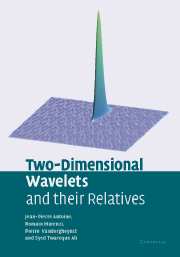Book contents
- Frontmatter
- Contents
- Prologue
- 1 Warm-up: the 1-D continuous wavelet transform
- 2 The 2-D continuous wavelet transform
- 3 Some 2-D wavelets and their performance
- 4 Applications of the 2-D CWT. I: image processing
- 5 Applications of the 2-D CWT. II: physical applications
- 6 Matrix geometry of wavelet analysis. I
- 7 Matrix geometry of wavelet analysis. II
- 8 Minimal uncertainty and Wigner transforms
- 9 Higher-dimensional wavelets
- 10 Spatio-temporal wavelets and motion estimation
- 11 Beyond wavelets
- Epilogue
- Appendix: Some elements of group theory
- References
- Index
7 - Matrix geometry of wavelet analysis. II
Published online by Cambridge University Press: 19 August 2009
- Frontmatter
- Contents
- Prologue
- 1 Warm-up: the 1-D continuous wavelet transform
- 2 The 2-D continuous wavelet transform
- 3 Some 2-D wavelets and their performance
- 4 Applications of the 2-D CWT. I: image processing
- 5 Applications of the 2-D CWT. II: physical applications
- 6 Matrix geometry of wavelet analysis. I
- 7 Matrix geometry of wavelet analysis. II
- 8 Minimal uncertainty and Wigner transforms
- 9 Higher-dimensional wavelets
- 10 Spatio-temporal wavelets and motion estimation
- 11 Beyond wavelets
- Epilogue
- Appendix: Some elements of group theory
- References
- Index
Summary
The last chapter has already familiarized us with the use of group theoretical methods for the construction and analysis of wavelets and gaborettes. We aim in this chapter to first indicate the general applicability of these techniques and then to look at the case of the two-dimensional continuous transform, using the SIM(2) group. Later, we look at general matrix groups of the type that can be used for constructing other types of wavelet transforms in two dimensions. We shall be led, in this manner, to studying a class of semidirect product type groups, certain coadjoint orbits of which are isomorphic to the group itself. In all these cases, the common features of such a matrix-group analysis will be: (a) the group will refer to a set of possible symmetry transformations which the signal may undergo; (b) the space over which the signals are defined (as L2-functions) is intrinsic to the group; (c) the parameters in terms of which the wavelet transform is expressed are the parameters of the group itself, i.e., symmetry parameters of the signal, and (d) these parameter spaces, which arise as coadjoint orbits of the group, are also identifiable with phase spaces of signals.
Referring back to the 2-D wavelet transform introduced in Chapter 2, we shall see that this transform is again related to a square integrable representation of a matrix group.
Information
- Type
- Chapter
- Information
- Two-Dimensional Wavelets and their Relatives , pp. 247 - 280Publisher: Cambridge University PressPrint publication year: 2004
